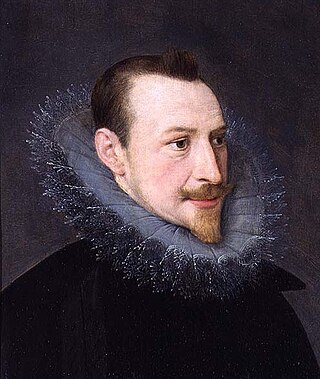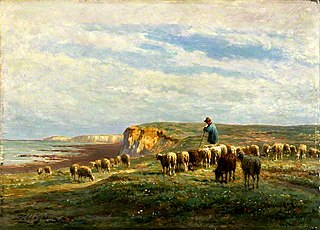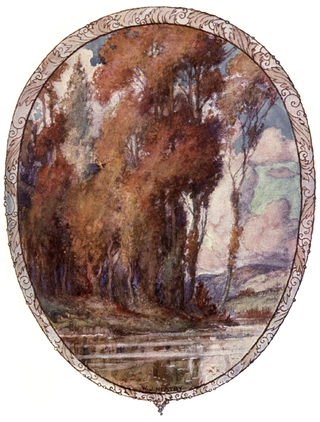
Edmund Spenser was an English poet best known for The Faerie Queene, an epic poem and fantastical allegory celebrating the Tudor dynasty and Elizabeth I. He is recognized as one of the premier craftsmen of nascent Modern English verse and is often considered one of the greatest poets in the English language.

An ode is a type of lyric poetry. Odes are elaborately structured poems praising or glorifying an event or individual, describing nature intellectually as well as emotionally. A classic ode is structured in three major parts: the strophe, the antistrophe, and the epode. Different forms such as the homostrophic ode and the irregular ode also enter.

Poetry, also called verse, is a form of literature that uses aesthetic and often rhythmic qualities of language − such as phonaesthetics, sound symbolism, and metre − to evoke meanings in addition to, or in place of, a prosaic ostensible meaning. A poem is a literary composition, written by a poet, using this principle.
A sestina is a fixed verse form consisting of six stanzas of six lines each, normally followed by a three-line envoi. The words that end each line of the first stanza are used as line endings in each of the following stanzas, rotated in a set pattern.

A villanelle, also known as villanesque, is a nineteen-line poetic form consisting of five tercets followed by a quatrain. There are two refrains and two repeating rhymes, with the first and third line of the first tercet repeated alternately at the end of each subsequent stanza until the last stanza, which includes both repeated lines. The villanelle is an example of a fixed verse form. The word derives from Latin, then Italian, and is related to the initial subject of the form being the pastoral.
Richard Barnfield was an English poet. His obscure though close relationship with William Shakespeare has long made him interesting to scholars. It has been suggested that he was the "rival poet" mentioned in Shakespeare's sonnets.
The Spenserian stanza is a fixed verse form invented by Edmund Spenser for his epic poem The Faerie Queene (1590–96). Each stanza contains nine lines in total: eight lines in iambic pentameter followed by a single 'alexandrine' line in iambic hexameter. The rhyme scheme of these lines is ABABBCBCC.

"To Autumn" is a poem by English Romantic poet John Keats. The work was composed on 19 September 1819 and published in 1820 in a volume of Keats's poetry that included Lamia and The Eve of St. Agnes. "To Autumn" is the final work in a group of poems known as Keats's "1819 odes". Although personal problems left him little time to devote to poetry in 1819, he composed "To Autumn" after a walk near Winchester one autumnal evening. The work marks the end of his poetic career, as he needed to earn money and could no longer devote himself to the lifestyle of a poet. A little over a year after the publication of "To Autumn", Keats died in Rome.

"Ode to a Nightingale" is a poem by John Keats written either in the garden of the Spaniards Inn, Hampstead, London or, according to Keats' friend Charles Armitage Brown, under a plum tree in the garden of Keats' house at Wentworth Place, also in Hampstead. According to Brown, a nightingale had built its nest near the house that he shared with Keats in the spring of 1819. Inspired by the bird's song, Keats composed the poem in one day. It soon became one of his 1819 odes and was first published in Annals of the Fine Arts the following July. The poem is one of the most frequently anthologized in the English language.
A rhyme scheme is the pattern of rhymes at the end of each line of a poem or song. It is usually referred to by using letters to indicate which lines rhyme; lines designated with the same letter all rhyme with each other.

"Ode on a Grecian Urn" is a poem written by the English Romantic poet John Keats in May 1819, first published anonymously in Annals of the Fine Arts for 1819.
An epithalamium is a poem written specifically for the bride on the way to her marital chamber. This form continued in popularity through the history of the classical world; the Roman poet Catullus wrote a famous epithalamium, which was translated from or at least inspired by a now-lost work of Sappho. According to Origen, the Song of Songs might be an epithalamium on the marriage of Solomon with Pharaoh's daughter.
This is a glossary of poetry.

Sonnet 153 is a sonnet by William Shakespeare.
A sonnet sequence is a group of sonnets thematically unified to create a long work, although generally, unlike the stanza, each sonnet so connected can also be read as a meaningful separate unit.

Sonnet 54 is one of 154 sonnets published in 1609 by the English playwright and poet William Shakespeare. It is considered one of the Fair Youth sequence. This sonnet is a continuation of the theme of inner substance versus outward show by noting the distinction between roses and canker blooms; only roses can preserve their inner essence by being distilled into perfume. The young man's essence or substance can be preserved by verse.

Amoretti is a sonnet cycle written by Edmund Spenser in the 16th century. The cycle describes his courtship and eventual marriage to Elizabeth Boyle.

Prothalamion, the commonly used name of Prothalamion; or, A Spousall Verse in Honour of the Double Marriage of Ladie Elizabeth and Ladie Katherine Somerset, is a poem by Edmund Spenser (1552–1599), one of the important poets of the Tudor period in England. Published in 1596, it is a nuptial song that he composed that year on the occasion of the twin marriage of the daughters of the Earl of Worcester, Elizabeth Somerset and Katherine Somerset, to Sir Henry Guildford and William Petre, 2nd Baron Petre respectively.

In 1819, John Keats composed six odes, which are among his most famous and well-regarded poems. Keats wrote the first five poems, "Ode on a Grecian Urn", "Ode on Indolence", "Ode on Melancholy", "Ode to a Nightingale", and "Ode to Psyche" in quick succession during the spring, and he composed "To Autumn" in September. While the exact order in which Keats composed the poems is unknown, some critics contend that they form a thematic whole if arranged in sequence. As a whole, the odes represent Keats's attempt to create a new type of short lyrical poem, which influenced later generations.
"Dejection: An Ode" is a poem written by Samuel Taylor Coleridge in 1802. The poem in its original form was written to Sara Hutchinson, a woman who was not his wife, and discusses his feelings of love for her. The various versions of the poem describe Coleridge's inability to write poetry and living in a state of paralysis, but published editions remove his personal feelings and mention of Hutchinson.











